 |
| FTLComm - Tisdale - June 15, 2000 |
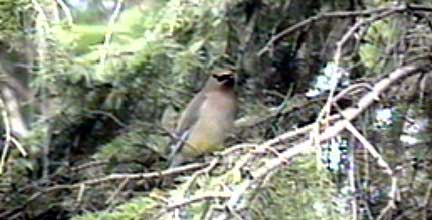 Though these pictures are close they were taken with a video camera and lack clarity. The sleek cedar waxwing has a nice yellow bar across the end of its tail and these ones have sharp red elbow markings. You will notice in these images the crest that so much distinguishes them is not always visible. These characters eat berries and insects. The Waxwing (Bombycillidae) family number only three species in the world and we have the pleasure of hosting two of them. Regular readers of |
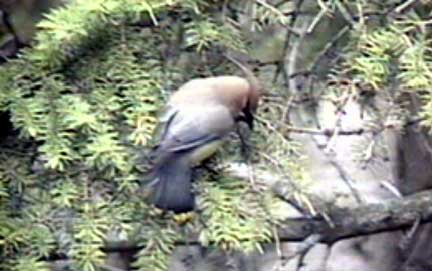 Ensign
will recall the visit Ensign
will recall the visitthis past winter of this specie's cousin the Bohemian Waxwing which disgraced themselves when they used the FTLComm van as a latrine The Cedar Waxwing though described as gregarious and that they fly in compact flocks are not as colonial as the Bohemians who this past winter were travelling in really large numbered groups. This group of Cedar Waxwings numbered only four up until their visit to my yard where one of them did a kamikaze run on the living room window and has gone to that great spruce tree in the sky. |
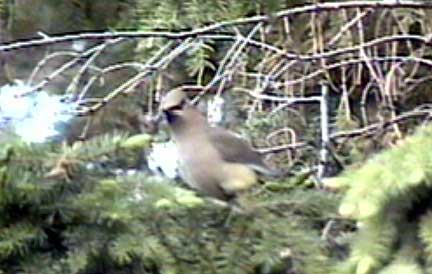 Removing his or her body from the front lawn was not a pleasant task because these are really beautiful animals and the fatal error of mistaking a window for air is truly a sad waste. One family with three large windows, a few blocks away, has hung a pattern of aluminum foil inside the windows to give curious birds a clue of the nature of transparency. The cool weather had prompted me to leave the drapes pulled back otherwise they normal indicate the impenetrability of the front window. Cedar Waxwings are not known for their music as they tend to produce a high |
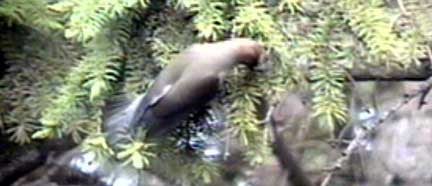 lisp
or "zeeee". lisp
or "zeeee".They breed here in Saskatchewan, Alberta, and British Columbia but also in Utah and Colorado. Because of their diet they are very adaptable and can handle winter as long as there are berries but they also can sail off to the Caribbean, Montana or Panama. They really like orchards but as you can see from these pictures Spruce trees seem okay because of the little |
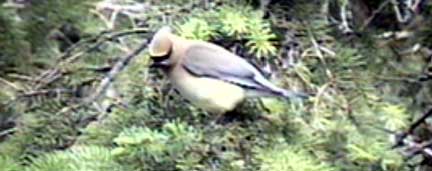 bugs
that also like Spruce bugs
that also like Spruce trees. They like to set up house with a cup of twigs, grass and moss on a horizontal branch where they lay three to six blue-gray dotted eggs. Very acrobatic fliers able to move effortlessly from tree to ground. The flight pictures were not shown here because of the blurring with wing movement but they can execute a marvellous full stop in flight going vertical and using their wings as air brakes to do a STOL (short take off and landing, a STOL landing with a fixed wing aircraft involves deploying full flaps and a steep descent angle with a quick flair and full brakes) approach on a limb. |